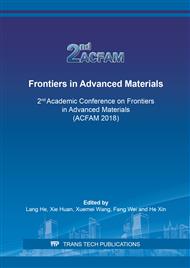p.273
p.282
p.294
p.305
p.317
p.324
p.332
p.342
p.352
Effect of Sodium Silicate on Properties of Magnesia Inorganic Lightweight Materials
Abstract:
Magnesia inorganic lightweight material was prepared by using magnesium cementitious materials as raw materials, sodium silicate solution as modifier, hydrogen peroxide solution as foaming agent, manganese dioxide as activator, calcium stearate as stabilizer and polyacrylamide as thickener in this paper. The effects of sodium silicate addition on the apparent density, mechanical strength, pore structure, crystalline phase and water resistance of magnesia inorganic lightweight material were discussed. The results show that when the content of sodium silicate is 7.5‰, the pore structure presents better morphology and the crystallization contains more 5·1·8 phases (strength phase). At this moment, the compressive strength and bending strength of the composite reached 10.35 MPa and 2.22 MPa, respectively. When the addition of sodium silicate exceeded 7.5‰, SEM and EDS presented that a large amount of sodium silicate and perforation appeared in the pores, meanwhile large number of perforations occurred between pores. XRD showed that the 5·1·8 phases and 3·1·8 phases in the materials changed into Mg (OH)2 crystals. These results in a significant decrease in material properties. Keywords: Magnesium cementitious material; Sodium silicate; Inorganic light materials; Pore structure
Info:
Periodical:
Pages:
342-351
Citation:
Online since:
June 2019
Authors:
Price:
Сopyright:
© 2019 Trans Tech Publications Ltd. All Rights Reserved
Share:
Citation:


